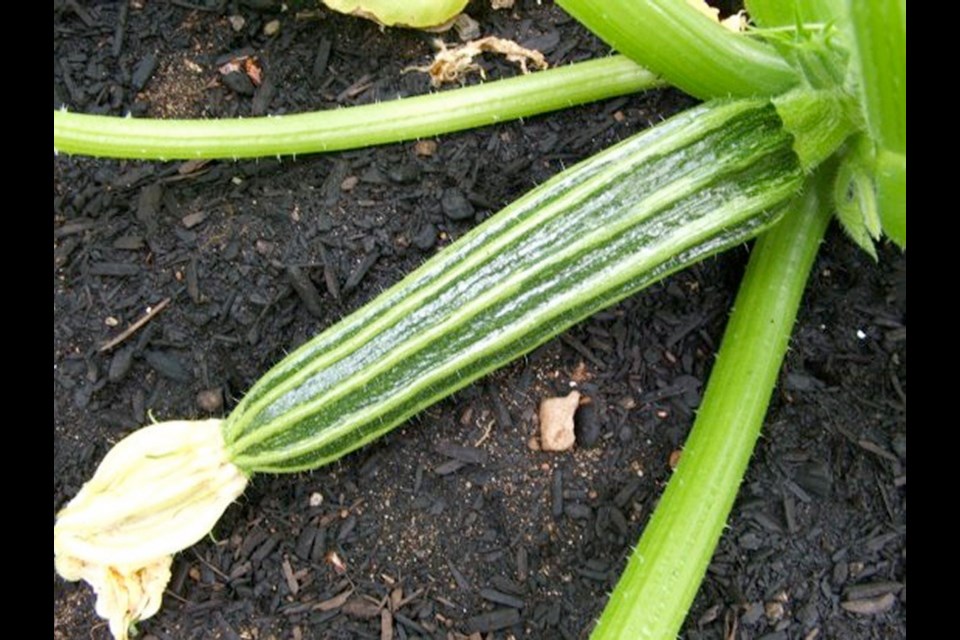Over the course of a long winter, memories of the first spring vegetables, fresh from the garden and full of flavour, fade away. This spring, that forgetfulness vanished magically with my first bite into a garden zucchini on May 25.
The zucchini was from one of two plants that were an experiment. I’ve never felt driven to have the first of anything edible from the garden. Still, I thought it might be fun, and possibly useful, to try for early zucchini this year. I seeded two small pots of a Romanesco zucchini indoors on March 9, and transplanted in April. I placed wire hoops over the plants to avert destruction by various nightly furry visitors. For a few weeks a floating row cover draped over the plants helped to gather a little warmth.
The first flowers in May were male, as usual. They’re the ones with long stems and no “baby bump” behind the flower. Then, just after mid-May, a zucchini began to form, with another one beneath it.
Romanesco. I chose a Romanesco zucchini because I find the flavour most appealing. These are the types of zucchini favoured, and sold in local summer markets, in Italy. The fruits are long, green-striped, and distinctly ridged. The texture is less watery than the usual smooth, green zucchinis and the flavour is pleasantly nutty.
I harvested that first little zucchini as I began constructing a salad for dinner, using the first wave of garden lettuces. It wasn’t the prettiest zucchini I’ve grown, but the flavour was spectacular.
In a large bowl I mixed a dressing of apple cider vinegar, olive oil, Dijon mustard, a dash of hot sauce, a teaspoon of mayonnaise, and finely grated ginger root. Into the blended dressing I put slim sticks of the zucchini and then shredded Little Gem and Tom Thumb (miniature romaine and butterhead) lettuce.
Not all the zucchini went into the salad. I ate half of it on the spot, relishing the burst of sweet, nut-like flavour. I reflected at the time on the experience as one of life’s sweet, simple pleasures that cannot be bought.
The variety of zucchini I seeded for the early planting has been dropped from the catalogue I used, but most sources list at least one “Romanesco” zucchini. Portofino from Lindenberg Seeds and Cassia from William Dam Seeds have done well for me.
Second seedings. At some point during the latter part of summer, as night temperatures cool and overnight dew increases, zucchini and other squash, pumpkin and cucumber plants commonly develop whitish, powdery patches on the leaves. It’s a fungus called powdery mildew.
Young plants, and young leaves on older plants, are largely resistant to infections from this disease. A second seeding in early summer yields plants that will remain largely unaffected by powdery mildew because the plants will still have fairly new leaves in late summer and early fall.
The second wave of zucchini plants often begins producing fruit just as the early plantings are doing a fast fade with their burden of mildew. Depending on the weather, the newer plants can produce young zucchinis well into autumn.
Many uses. Few vegetables can be prepared and consumed in as many ways as zucchini. Sliced or cut in chunks, lightly steamed and eaten with butter, salt and pepper, it’s an ideally light, mild-flavoured accompaniment to meat meals, especially pork. Zucchini is a surprisingly good frozen vegetable to enjoy in winter.
I’m fond of young zucchini sliced lengthwise, browned in butter, and doused with freshly squeezed lemon.
Zucchini is used in breads, squares, and cakes. An longtime early summer favourite is an Italian tart (Torta salata di zucchine) made with onion, sliced zucchini, eggs and cream. Romanesco zucchinis are used for this recipe in Italy.
I try to use garden zucchinis while they remain young, but as the summer progresses it is inevitable that some are left to grow large. These ones are still good for freezing, and for soup. Cooked with onion, garlic, and water or vegetable broth and puréed with an immersion blender, the resulting purée can be frozen in tubs and used in winter as soup with additions of milk or cream.
Plant sale. Ross Bay Villa Society will hold an outdoor plant sale and white elephant sale next Saturday, June 20, from 11 a.m. to 3 p.m. at 1490 Fairfield Rd, to benefit the heritage house museum.



